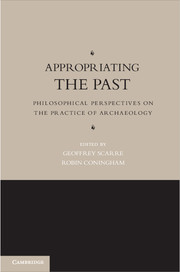Book contents
- Frontmatter
- Contents
- Contributors
- Editors
- Chapter 1 Introduction
- Part One Claiming the Past
- Part Two Problems of Meaning and Method
- Part Three Problems of Ownership and Control
- Chapter 13 Legal Principles, Political Processes, and Cultural Property
- Chapter 14 Monuments versus Moveables
- Chapter 15 Looting or Rededication?
- Chapter 16 Partitioning the Past
- References
- Index
Chapter 15 - Looting or Rededication?
Buddhism and the Expropriation of Relics
Published online by Cambridge University Press: 05 December 2012
- Frontmatter
- Contents
- Contributors
- Editors
- Chapter 1 Introduction
- Part One Claiming the Past
- Part Two Problems of Meaning and Method
- Part Three Problems of Ownership and Control
- Chapter 13 Legal Principles, Political Processes, and Cultural Property
- Chapter 14 Monuments versus Moveables
- Chapter 15 Looting or Rededication?
- Chapter 16 Partitioning the Past
- References
- Index
Summary
Recent surveys of archaeological sites in northern Sri Lanka have highlighted a high level of destruction, in particular at Buddhist monastic sites. Whilst this includes damage resulting from the expansion of agricultural fields and villages or the quarrying of ancient stone slabs and pillars for building materials, most image houses and stupas have been targeted for their Buddhist relics. This is by no means an isolated phenomenon, and scholars have recorded similar levels in the Gandhara region of Pakistan and Afghanistan (Ali and Coningham 2001), as well as in the Kathmandu Valley of Nepal (Schick 1998). Such activities are illegal, as South Asian archaeological and historical sites are protected by strict laws attributing ownership of any materials over one hundred years old to the state. Indeed, although these statutes have been modernised by individual states belonging to the South Asian Association for Regional Cooperation (SAARC), as in the 1998 Sri Lankan Antiquities Ordinance or the 1972 Indian Antiquities and Treasures Act, they all owe much to the original ordinances of the Raj. Thus, Sri Lankan law lays down that “all undiscovered antiquities (other than ancient monuments), whether lying on or hidden beneath the surface of the ground or in any river or lake or within the territorial sea of Sri Lanka, shall be deemed to be the absolute property of the Crown, subject to the provisions of this Ordinance” (1956 Government of Ceylon Antiquities Ordinance I.2). The existence of such clear and precise legislation has enabled many court cases involving looters and treasure hunters to be successfully pursued, resulting in heavy fines and custodial sentences.
- Type
- Chapter
- Information
- Appropriating the PastPhilosophical Perspectives on the Practice of Archaeology, pp. 281 - 294Publisher: Cambridge University PressPrint publication year: 2012
- 1
- Cited by



